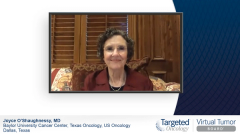
Case 1: Practical Experience With the HER2CLIMB Regimen
The panelists discuss clinical experience with the HER2CLIMB regimen, including main adverse effects.
Episodes in this series

Joyce O’Shaughnessy, MD: I want to take a minute and hear from everybody. Talk about your experience using T-DXd [trastuzumab deruxtecan] in your practice. We have this patient here. Just from the patients you’ve used it on, from any particular efficacy point you’d like to make, also of great interest is toxicity. What are you seeing toxicity-wise? Have you encountered any ILD [interstitial drug disease]? Have you seen asymptomatic ground glass? What are you doing about it? Bill, let me ask you.
William Gradishar, MD: To date, my gut impression about using T-DXd, trastuzumab deruxtecan, has been favorable. I’ve seen good responses, even in patients with refractory, inflammatory skin disease—it’s not going away completely but dramatically improving, and the effect is sustained. Most patients, if not all, have responded at this point that we’ve treated. We’ve been fortunate, quite frankly. We haven’t seen any ILD. We haven’t seen any patients who had convincing respiratory symptoms that we were concerned about. If you go by the numbers, there is somebody I’m going to be seeing soon somewhere that’s going to have that problem. But to date, that has not been the issue. It’s been other more hematologic adverse effects than anything.
Joyce O’Shaughnessy, MD: Thanks. How about you, Adam? What’s been your experience so far?
Adam Brufsky, MD, PhD: We participated in DESTINY-Breast01, and the patient died. We didn’t even know what it was. That’s how clueless we were. We thought it was some bronchiolitis obliterans. We debated. The pulmonologist would not come off that. We had to adjudicate it because it was 1 of the deaths on the trial. Other than that, it’s been well tolerated. You get the usual adverse effects. You lose your hair, you get some hematologic adverse effects like diarrhea but nothing out of the ordinary. Most people have tolerated it well. I have not seen any ILD yet, thankfully.
Joyce O’Shaughnessy, MD: How about you, Mark?
Mark Pegram, MD: We’ve had success with trastuzumab deruxtecan in our practice at Stanford. In fact, I know of a couple of cases that were presented at our tumor board by my colleagues in patients that had symptomatic pulmonary metastasis. The query was, should you risk giving somebody a drug that could cause ILD in somebody who already has symptomatic metastasis? The answer from our group was, yes, you should do it because the way to get rid of the pulmonary symptoms is to affect a response with the most active agent available. Both those patients did respond anecdotally, even though they weren’t my patients.
I saw 2 patients in my clinic on trastuzumab deruxtecan. One had it in the past and wasn’t able to stay on it long because of the first restaging interval. No. 1, she had grade 1 ILD on CT scan, asymptomatic, but at the same time she developed a new brain metastasis, so we switched her to tucatinib. Fortunately, the ILD resolved on the follow-up staging interval, and it was of no clinical consequence. That’s the only ILD at our institution thus far. The second patient I saw on Wednesday is about 80 years old, a widely metastatic disease. She already had tucatinib for brain metastasis and then progressed extracranially. I put her on trastuzumab deruxtecan, and she’s enjoying a nice partial response that’s been durable thus far. She’s at the 4.4-mg/kg dose level. We did have to drop a dose level after the first dose, because of her size and her age, which is not surprising. It’s well tolerated, and she’s pleased that it’s been durable. I’ve had a good experience.
Joyce O’Shaughnessy, MD: I have too. I have also found it to be highly not cross-resistant. We have these patients who run a biology that’s halfway between basal and halfway between HER2 [human epidermal growth factor receptor 2]–amplified diseases. Many times they’re not responsive to HER2-based therapies. They’re a rarer subset, but we all have seen these. They’re HER2 amplified, but they’re not acting like it. Those patients don’t do well with a lot of our traditional therapies. I’m thinking about a patient who enjoyed a marvelous response, very symptomatic, horrible lung metastases. She received dramatic symptom relief that was durable. She hadn’t responded to a lot, and she’s getting this because we’re monitoring her response and CT scans. She develops this tiny patch of a ground glass. I know the guidelines say you’re supposed to stop it and give some steroids to get rid of it, then restart at the same dose if they reverse their CT within 30 days or a reduced dose if it takes longer than 30 days. It was a little patch. I thought, “I don’t know what that is.” I didn’t want to stop it because she hadn’t had any luck with anything else, and I did a short interval follow-up. Fortunately, it was gone. It is a bit of a dicey thing, but it sounds like, Mark, you guys erred on the side with your patient. You saw some early changes, she was asymptomatic, and you stopped. Did you give some steroids at that point?
Mark Pegram, MD: No, she had progressed in the brain at the same time as that last CT; consequently, we changed to a different regimen at that point anyway.
Joyce O’Shaughnessy, MD: You think you would, though, in general. If you wanted to continue the T-DXd [trastuzumab deruxtecan], would you have stopped and given some steroids?
Mark Pegram, MD: The prescribing information suggests that you should stop all treatment and then consider. It says steroid administration and 0.5 mg/kg of prednisolone equivalent. The cut point is on day 28. If there’s a resolution, you could continue at the same dose if it’s resolved by day 28. If it’s longer than day 28, then you’re supposed to decrease by 1 dose level, and if it’s longer than 49 days, then you’re supposed to discontinue permanently.
Joyce O’Shaughnessy, MD: Thanks for reminding us of those guidelines, which are put together by the experts who adjudicated all these cases. Thank you.
Transcript edited for clarity.















































